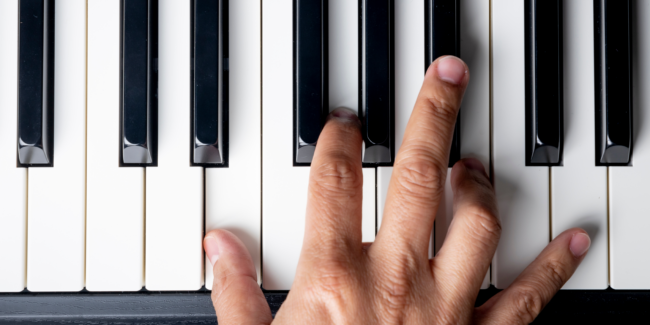Playing the E Minor Chord on Piano

Trying to play a song with an E minor chord? Look at this guide to playing the E minor chord in all its forms.
When you look down at the keys, you might feel flustered by all the possibilities. You’re not alone – chords can be tricky for beginners. This short article reveals all the tricks from music theory to help you play the E minor chord.
Understanding chords and inversions.
A chord is when you play a combination of two or more notes together. The most basic chord has three notes, called a triad.
To play a major chord, you take the first, third, and fifth notes of a major scale and play them together. You build them from two intervals, a major third, and a minor third.
A minor chord comprises these two intervals but in the reverse order—first a minor third and then a major third. You build it from the major scale’s first, third, and fifth notes, but the third is flat (lower by a semitone).
An inversion is when you play these three notes in a different order. You can play triads in three different positions.
Root position: 1, 3, 5.
First inversion: 3, 5, 1.
Second inversion: 5, 1, 3.
You can read more about chords and inversions here.
Understanding the E minor chord.
The major scale is an excellent place to figure out any chord type. To unlock E minor, let’s start from the E major scale.

You can play an E major chord by taking the scale’s first, third, and fifth degrees.

To make this chord minor, flatten the third (the second note of the chord).
E minor chord in root position:

First inversion of E minor.
Remember, the 1st inversion is when you play the chord in the following order:
3, 5, 1.

Second inversion of E minor.
The 2nd inversion is when you play the chord in this order:
5, 1, 3.

Advanced tip: Add the ninth.
Want to make your chord a little spicier? Add a nine! The ninth is just the second degree of the scale. We call it nine and not two because you play it one octave higher than the chord’s root note. Usually, when you play the nine, you also add the seven.
The seventh of E is D#, or D if it’s flat. The ninth of E is F#. Check out this table to learn how to use the ninth with E major and minor chords. If you’re sitting at the piano, make sure the E is the lowest note in the chord.

Popular songs with the E minor chord:
Do you feel ready to learn some popular songs which use the E minor chord? Try these:
- Purple Haze – Jimmi Hendrix
- Paranoid – Black Sabbath
- Breaking the Habit – Linkin Park
- Come As You Are – Nirvana
Make music!
Don’t be scared of chords! Practice playing E minor with the help of this article. You can download the Simply Piano app for interactive learning and step-by-step assistance playing E minor and other chords.









